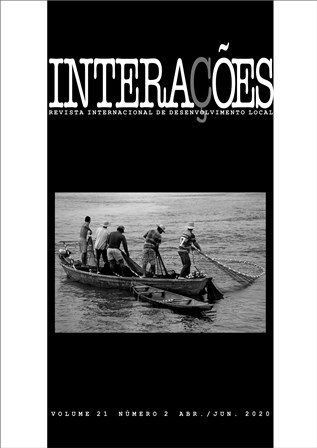Identity and social representations of residents of the south of the city of Rio de Janeiro about themselves, the residents of the suburbs and the <i>Cariocas</i>
Keywords:
carioca, identidade, representação social, pensamento social, Rio de JaneiroAbstract
This article deals with the beliefs of residents of the south of the city of Rio de Janeiro about themselves, the people living in the suburbs, and the Cariocas in general. The theoretical approach is composed of the theory of social representations, more precisely its structural approach elucidated by the central core theory, and the theory of social identity. The method involves a questionnaire that includes Likert items about what it is to be Carioca, exemplified by its most striking characteristics, and free evocations with the terms “Carioca” inductors, “southern residents” and “suburban residents”. The research participants are 100 residents of the southern zone of Rio de Janeiro in the administrative regions of Lagoa and Botafogo. Data analysis of Likert items was done using ANOVA and the free evocations were performed through prototypical analysis. The results show that the social representation and the identity of the residents of the southern zone seem to be based on more positive and distinct characteristics of the representation of the suburban residents. Also, both categories of residents of the two zones of Rio de Janeiro, suburban and southern zone, appear as a cut of a larger category, the category of Carioca.
References
ABRIC, Jean-Claude. Abordagem estrutural das representações sociais: desenvolvimentos recentes. In: CAMPOS, Pedro H. F.; LOUREIRO, Marcos C. da S. (Org.). Representações sociais e práticas educativas. Goiânia: Editora da UCG, 2003. p. 37-57.
ABRIC, Jean-Claude. Pratiques sociales et représentations. Paris: Presses Universitaires de France, 1994.
BENCHIMOL, Jaime Larry. Pereira Passos: um Haussmann tropical: a renovação urbana da cidade do Rio de Janeiro no início do século XX. Rio de Janeiro: Prefeitura, Secretaria Municipal de Cultura, Turismo e Esportes, Departamento Geral de Documentação e Informação Cultural, 1990.
CARDOSO, Elizabeth Dezouzart. Estrutura urbana e representações: a invenção da Zona Sul e a construção de um novo processo de segregação espacial no Rio de Janeiro nas primeiras décadas do século XX. GeoTextos, Salvador, BA, v. 6, n. 1, p. 73-88, jul. 2010. Disponível em: https://rigs.ufba.br/index.php/geotextos/article/view/4306/3165.
DESCHAMPS, Jean-Claude; MOLINER, Pascal. A identidade em Psicologia Social: dos processos identitários às representações sociais. Petrópolis, RJ: Vozes, 2009.
FEIJÃO, Rosane. As praias e as transformações de sensibilidade no Rio de Janeiro nos anos 1920. In: CONGRESSO DE ESTUDANTES DE PÓS-GRADUAÇÃO EM COMUNICAÇÃO − CONECO, 6., 2013, Rio de Janeiro. Anais [...]. Rio de Janeiro, 2013.
FERNANDES, Nelson. O rapto ideológico da categoria subúrbio: Rio de Janeiro 1858|1945. Rio de Janeiro: Apicuri, 2011.
FESTINGER, Leon. A theory of social comparison processes. Human Relations, v. 7, n. 2, p. 117-40, 1954. Disponível em: http://journals.sagepub.com/doi/abs/10.1177/001872675400700202?journalCode=huma.
GOLDENBERG, Mirian. Nu & vestido: dez antropólogos revelam a cultura do corpo carioca. Rio de Janeiro: Record, 2002.
GONTIJO, Fabiano. Carioquice ou carioquidade? Ensaio etnográfico das imagens identitárias cariocas. In: GOLDENBERG, Mirian (Org.). Nu & vestido: dez antropólogos revelam a cultura do corpo carioca. Rio de Janeiro: Record, 2002. p. 41-77.
MALHORTA, Naresh. Pesquisa de marketing: uma orientação aplicada. Tradução: Laura Bocco. 4. ed. Porto Alegre: Bookman, 2006.
MOSCOVICI, Serge. A representação social da Psicanálise. Rio de Janeiro: Zahar, 1978.
MOSCOVICI, Serge. La psychanalyse, son image et son public. Paris: PUF, 1961.
OLIVEIRA, Denise Cristina; MARQUES, Sergio C.; GOMES, Antônio Marcos T.; TEIXEIRA, Maria Cristina T. V. Análise de evocações livres: uma técnica de análise estrutural das representações sociais. In: MOREIRA Antônia S. P.; CAMARGO, Brígido V.; JESUÍNO, Jorge C.; NÓBREGA, Sheva M. (Ed.). Perspectivas teóricometodológicas em representações sociais. João Pessoa, PB: UFPB, 2005. p. 573-603.
SÁ, Celso Pereira. As representações sociais na história recente e na atualidade da psicologia social. In: JACÓ-VILELA, Ana Maria; FERREIRA, Arthur Arruda Leal; PORTUGAL, Francisco Teixeira (Org.). História da psicologia: rumos e percursos. 2. ed. rev. e ampl. Rio de Janeiro: Nau, 2007. p. 587-602.
SÁ, Celso Pereira. Núcleo central das representações sociais. Petrópolis, RJ: Vozes, 1996.
TAJFEL, Henri. Grupos humanos e categorias sociais I. Lisboa: Livros Horizonte, 1982.
TAJFEL, Henri. La catégorisation sociale. In: Serge Moscovici (Org.). Introduction à la Psychologie Sociale. Paris: Larousse Université, 1972. v. 1.
Downloads
Published
How to Cite
Issue
Section
License
Direitos Autorais para artigos publicados nesta revista são do autor, com direitos de primeira publicação para a revista. Em virtude de aparecerem nesta revista de acesso público, os artigos são de uso gratuito, com atribuições próprias, em aplicações educacionais e não-comerciais.


